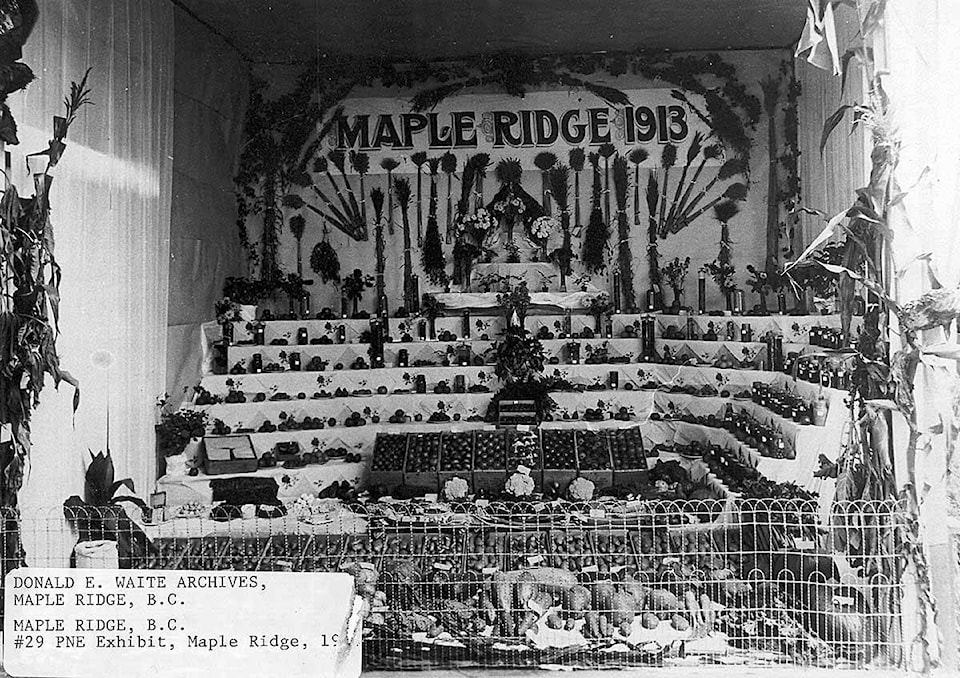Maple Ridge has prided itself on its farms for more than 100 years.
Almost every year since 1901, the fall fair (now Country Fest) has celebrated farm products and life. ‘While most residents now find their livelihoods elsewhere, late summer and autumn are times for the harvest of many cherished crops and the history of agriculture to be celebrated.
Early in its development, a prominent group of residents undertook to “encourage the cultivation of the soil and the general development of all agricultural resources of the district and to foster every branch of mechanical and household arts calculated to increase the happiness of home life,” according to the constitution of the Maple Ridge Agricultural Association, signed on June 15, 1901.
The first ‘Fall Fair’ was held in September 1901, at the town hall on Callaghan Street and its surrounding grounds, where livestock pens were quickly erected.
There were 496 entries and 76 members enrolled in the association. ‘
As there were limited funds, only 75 per cent of each cash prize was paid to the winners. Money raised and ground improvements were the preoccupations of the association during its early days.
Thomas Haney leased the Callaghan Street show grounds to the group, with an option to buy.
By 1905, the association felt itself on strong enough financial footing to purchase the Callaghan Street show grounds from Thomas Haney for $200, giving him $50 down, with a mortgage on the balance.
The fair moved to a five-acre site in the downtown core area in 1908. In a successful venture into real estate, the association subdivided the old grounds into 10 lots, sold them at an auction for a total of over $1,000, and purchased the new five-acre grounds from Thomas Haney for $700.
The Aggie Hall was a landmark in Haney’s recreational life. It was built to plans prepared by Hector Ferguson, Nelson Lougheed and A. Baillie, financed with a $1,000 loan floated on the association’s assets, and formally opened with a concert on Sept. 7, 1909.
The hall faced Hinch Road (225th Street) on the southeast corner of the grounds. Improvements to the speedily built hall soon followed.
A maple floor was laid in 1910, which is why it was such a popular dance floor. The hall was wired for lighting, and an annex was built in 1912. The exterior of the hall was sided in 1914.
Over the years, Aggie Hall was used for many meetings, parties, dances, weddings, concerts, sports and club meetings.
The financial burden of taxes, improvements, and the running expenses influenced the association to hand over the fair grounds to Maple Ridge council for a token $1, provided the municipality could always hold fairs there, and that the grounds would not be sold for commercial purposes.
After the council purchased the 60-acre grounds in Albion, this covenant was conveyed to the new land when the two parcels were exchanged in 1959.
The hall remained in use until the middle 1960s, when it was torn down for a parking lot for the new arena.
The rich history of fall fairs, exhibiting and displaying to the community at large not only increase awareness about the agricultural community, but also celebrates diversity and is an educational tool for sustainability.
As this excerpt from the Gazette, from July 6, 1922 – talking about the provincial fair – reads: “The crowds will be there, and Maple Ridge cannot afford to be absent from the reception. The district exhibit works for good in so many ways. Not only is it the finest form of advertising – that of ‘showing the goods’ to the largest annual gathering of spectators, but a usefulness almost as great as in the heartening effort on the producers themselves.”
Farming facts:
• The land that slid into the Fraser River during the Great Haney Landslide had just been planted with potatoes. In 1896, a farmer got 1.5 cents per pound for their potatoes.
• The Hampton and Laity farms are the oldest working farms in the city and have been in those family’s hands for 133 years.
In order to gain title to their homesteads, farmers had to clear and fence five acres in their first year, crop those acres and clear five more in their second year as well as building a house. That accomplished, they got the land for $1 per acre.
• By 1930, Japanese settlers owned nearly 3,000 acres in Maple Ridge with 640 of those acres in strawberries.
Allison White is curator at Maple Ridge Museum and Haney House.
